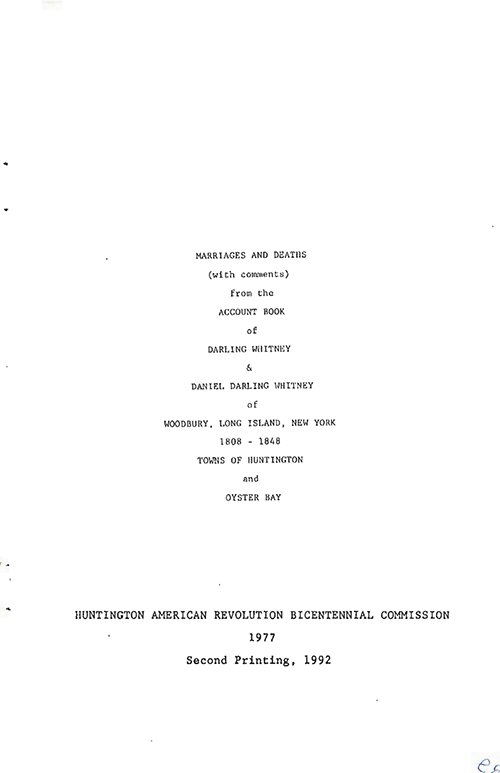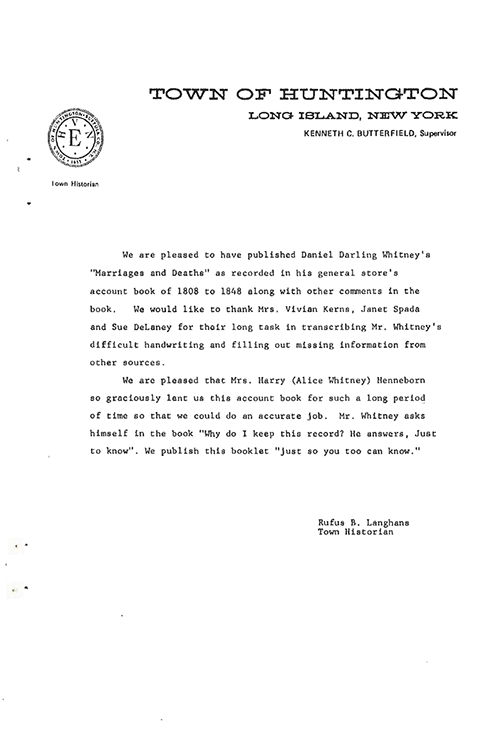Forums
I purchased a booklet several years ago in PDF format published by a local historical society. It's supposed to be a transcription of an old store account book in which the owner logged marriages and deaths in a local town in NY. The original booklet is not paginated, contains no section headers, (nor is there any implied sections. Marriages and deaths are not chronological, alphabetical or even separated into 2 groups). I'm having a hard time putting together the citation.
This is what I have so far.
Marriages and Deaths (with comments) from the Account Book of Darling Whitney and Daniel Darling Whitney of Woodbury, Long Island, New York, 1808-1840: Towns of Huntington and Oyster Bay, (New York: Huntington American Revolution Bicentennial Commission, 1977, second printing, 1992) PDF, 11, entry for Maria White. This is a transcription from the original account book of Darling and Daniel Darling Whitney of Oyster Bay. "The transcribers have shown the “proper” spelling of an individual’s name when it was known to them, indicated by brackets. Information that was not in the original book but was included to the published version is underlined. There are no page numbers in the original book".
Questions :
1. The booklet is unpaginated. Is it acceptable to substitute the PDF page number and then explain in a in the subsequent note that the original was not paginated?
2. Should I include the names of the three transcribers?


Eventide, you've done an…
Eventide, you've done an excellent job of analyzing what you are using, to understand its strengths and weaknesses. From the citation standpoint, let's go back to basics: a book or booklet (it does not matter what size the book is) follows the basic book format:
Author/compiler, Title of Publication (Place of publication: Publisher, Date of publication), page no.
You've done that, except for citing the compilers whose identities definitely should be noted. Aside from the point of giving credit where due, their reputations for skill (or sometime a lack of it) is essential to the analysis of the work and its reliability.
When you say that the work is a PDF, I assume you are using it in a digital form. If so, then we still need to identify the media in which you are using those PDF images: CD, thumb drive, online access etc.
Regarding the lack of page numbers, EE 12.14 "Page Numbers, Missing" states:
Most published books are paginated. When you use one that is not, you should state the absence of pagination and look for some means by which the specific page can be identified.
"Looking for some means" is what you've done. Your explanation would be clearer if, in that page numbered field, you stated:
... unnumbered pages, PDF image 11, entry for Maria White.
One other point might be clarified. In your description of the source and its strengths and weaknesses, you end with a long sentence that carries quotation marks; but you don't say where the quote comes from. The preface?
The PDF is on my hard drive…
The PDF is on my hard drive. I got it so long ago I don't remember the details of exactly how I obtained it. I think I purchased it from the historical society, but its also possible a relative sent me a copy of theirs. Not sure if or what I need to state in the citation.
The quote came from the preface of the book and thought it would be important to include since it spells out exactly what changes have been made. It sure makes for a long citation though!
Here's another stab at it:
Vivian Kerns, Janet Spada, Sue DeLaney, transcribers, Marriages and Deaths (with comments) from the Account Book of Darling Whitney and Daniel Darling Whitney of Woodbury, Long Island, New York, 1808-1840: Towns of Huntington and Oyster Bay. (New York: Huntington American Revolution Bicentennial Commission, 1977, second printing, 1992) PDF, unnumbered pages, PDF page 11, entry for Maria White. This is a transcription from the original account book of Darling and Daniel Darling Whitney of Oyster Bay. The preface states "The transcribers have shown the “proper” spelling of an individual’s name when it was known to them, indicated by brackets. Information that was not in the original book but was included to the published version is underlined."
Ah, the lessons we learn the…
Ah, the lessons we learn the hard way! With a PDF, it does make a difference as to where/how we obtained the record. If from a third party, we have no assurance that all the original publication is there or that something has not been altered. Alterations are easy to make with PDFs used outside of DRM (digital rights management) software.
At this point, making do with what you've got, your analysis of essentials is good. Everything is there, somewhere, and most of it is in the logical place. A bit of redundancy could be eliminated to shorten the quite long citation. EE's tweaks would be these.
1. Vivian Kerns, Janet Spada, Sue DeLaney, transcribers, Marriages and Deaths (with Comments) from the Account Book of Darling Whitney and Daniel Darling Whitney of Woodbury, Long Island, New York, 1808-1840: Towns of Huntington and Oyster Bay, PDF ed. (1977; reprint, New York: Huntington American Revolution Bicentennial Commission,
1977, second printing,1992)PDF,unnumbered pages, PDFpagep. 11, entry for Maria White. This small publication is a transcription from the original account bookof Darling and Daniel Darling Whitney of Oyster Bay. The preface states "The transcribers have shown the 'proper' spelling of an individual’s name when it was known to them, indicated by brackets. Information that was not in the original book but was included to [sic] the published version is underlined."Reasons:
Makes perfect sense. Thank…
Makes perfect sense. Thank you for putting me on the right track.
You're welcome!
You're welcome!
I hope you don't mind me…
I hope you don't mind me asking some follow-up questions.
I want to revisit this because I decided that instead of relying on a PDF of unknown origins, that I would purchase the physical booklet. It’s an entirely different animal and there are many entries that I will need to cite.
It does not have page numbers and it’s arranged into 2 implied sections, marriages and deaths. There is nothing to distinguish the two sections other than a page in between with a short poem that starts with “In memory of a few inhabitants…” Each section is alphabetical by surname and then chronological.
The marriage section will have 2 entries, under the surnames of the bride and also the groom.
This is my first attempt at a citation. (there are additional notes at the end regarding the transcriptions but I will leave them out for now)
Vivian Kerns, Janet Spada, Sue DeLaney, transcribers, Marriages and Deaths (with comments) from the Account Book of Darling Whitney and Daniel Darling Whitney of Woodbury, Long Island, New York, 1808-1840: Towns of Huntington and Oyster Bay, typescript, (1977; reprint, New York: Huntington American Revolution Bicentennial Commission, 1992), unnumbered pages, entry for Hendrickson Amanda to "Nelson White" [Charles Nelson White].
But I have a few questions.
Eventide, you’ve definitely…
Eventide, you’ve definitely found a doozie!
Question 1:
With compilations that take records out of original order and rearrange them alphabetically, we do sometimes find that a marriage entry for a couple will appear in the alpha section for both the bride's name and the groom's. We may also find that different details appear from one to the other. If you've compared the two and find no differences, then no one would fault you for citing just one of the entries. On the other hand, with books whose data is taken out of context and subdivided under the "right letter of the alphabet," users miss contextual information if they do not examine both entries. EE would likely cite both or add a note that both letters of the alphabet should be checked.
Question 2:
Yes. This seems to be one of those cases in which an added explanation would help. As a comparison, see EE 7.15 (“Record Books, Sectioned”), the St. Peter’s Parish example.
Question 3:
Here, the advice at 7.5 “Citing Entry vs. Page Numbers” would be your guidance: “You will need to study the overall arrangement of each register you use and plan your citation to include whatever numbers are needed to identify your entry.” There’s no hardfast rule.
Whether to count physical pages, in an unpaginated work, is a matter of feasibility. If there are just a few pages in each section, it’s feasible (example: EE 12.14 “Page Numbers, Missing,” for St. James example. If there are 59 pages, it's problematic—which means we another type of pointer. Two variants for these situations are at
Regarding your latest citation draft, EE would tinker just a bit:
Vivian Kerns, Janet Spada, Sue DeLaney, transcribers, Marriages and Deaths (with comments) from the Account Book of Darling Whitney and Daniel Darling Whitney of Woodbury, Long Island, New York, 1808-1840: Towns of Huntington and Oyster Bay
,typescript,(1977; reprint, New York: Huntington American Revolution Bicentennial Commission, 1992) …A typescript is a manuscript presented in typed form—i.e., unpublished. (See Glossary, p. 832). That does not fit in this case in which you are citing the work as a publication.
You gave me a lot to think…
You gave me a lot to think about and I spent several hours thinking about how to put it together becausethere are a few other considerations such as comments regarding how the "transcriptions" were put together and altered. Here's a go at it, although it is quite lengthy.
Vivian Kerns, Janet Spada, Sue DeLaney, transcribers, Marriages and Deaths (with comments) from the Account Book of Darling Whitney and Daniel Darling Whitney of Woodbury, Long Island, New York, 1808-1840: Towns of Huntington and Oyster Bay (1977; reprint, New York: Huntington American Revolution Bicentennial Commission, 1992), unnumbered pages, entries are alphabetical then chronological order, marriage entry for Hendrickson Amanda to "Nelson White" [Charles Nelson White]. Marriages can be found in the front of the book, while deaths appear following a poem found in the exact center of the book. The preface states "The transcribers have shown the 'proper' spelling of an individual’s name when it was known to them, indicated by brackets. Information that was not in the original book but was included in the published version is underlined.*" It also states "This added information came from the records of the Old First Presbyterian Church of Huntington and the local newspaper, The Long Islander."
Thoughts?